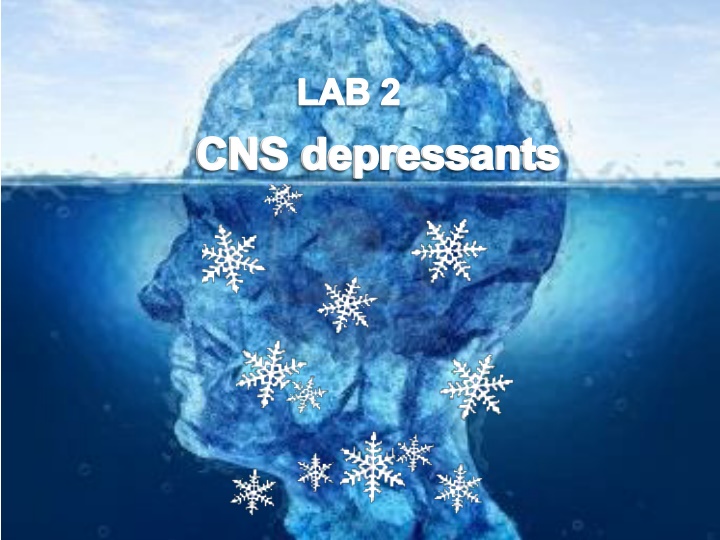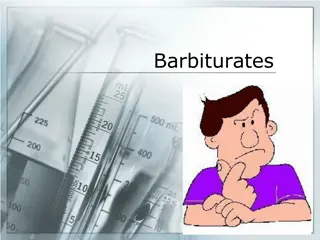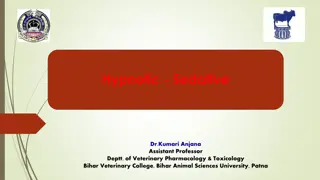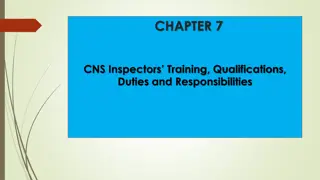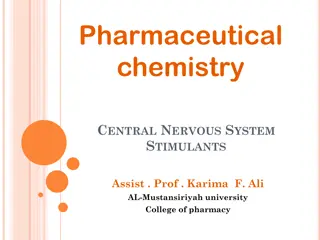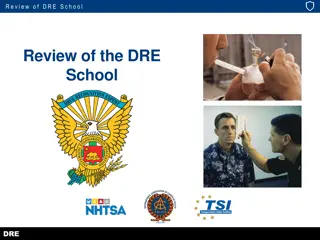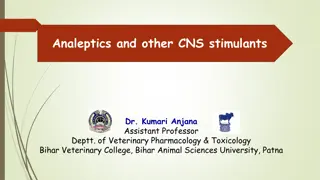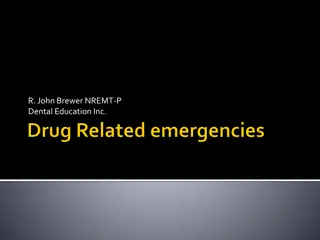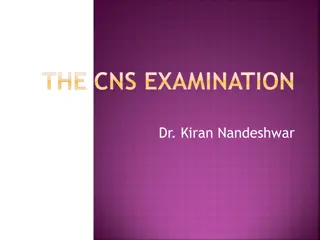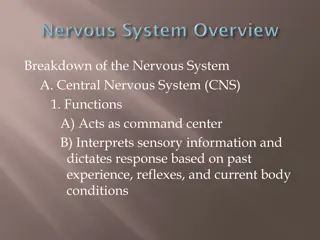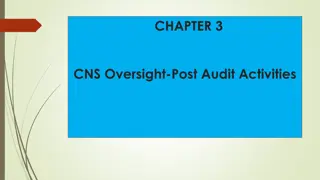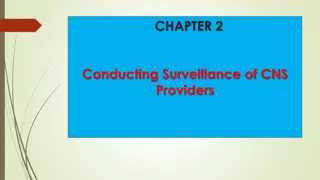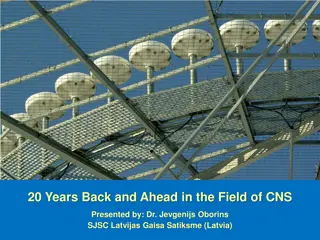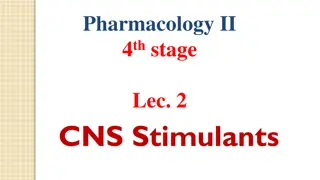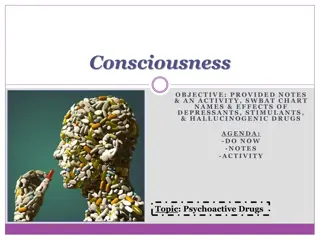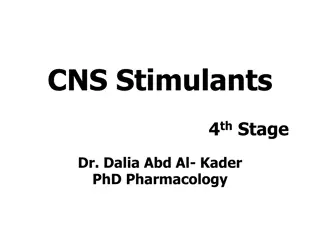CNS depressants
Explore the effects of CNS depressants - from slowing brain and body reactions to the risks of overdose and the classification of depressant drugs based on pharmacological action. Discover how depressants impact neurotransmitters like GABA and the characteristics of general anesthesia. Dive into the world of CNS depressants in this informative content.
Download Presentation

Please find below an Image/Link to download the presentation.
The content on the website is provided AS IS for your information and personal use only. It may not be sold, licensed, or shared on other websites without obtaining consent from the author.If you encounter any issues during the download, it is possible that the publisher has removed the file from their server.
You are allowed to download the files provided on this website for personal or commercial use, subject to the condition that they are used lawfully. All files are the property of their respective owners.
The content on the website is provided AS IS for your information and personal use only. It may not be sold, licensed, or shared on other websites without obtaining consent from the author.
E N D
Presentation Transcript
LAB 2 CNS depressants CNS depressants
A stimulant is a drug that speeds up activities of the CNS A depressant is a drug that slows brain and body reactions Depressants decrease Stimulants increase HR Increase Motor Activity. Increase Alertness. Decrease need for Sleep Relax muscle tension Lower alertness Cause drowsiness RR BP
Over dose Respiratory failure Coma, loss of reflexes, Unconsciousness Cardiac dysrhythmias Seizures, Confusion, Severe CNS Higher dose Insomnia Nervousness, Excessive talking, Hyperactivity, Decreased perception of heat or cold Sleep Drowsiness Moderate CNS increase dose Decreased fatigue Mental alertness, Wakefulness, Inability to focus Decreased interest in surroundings, Mild CNS Low dose
Classification on CNS depressant (pharmacological action) 1. General Anesthetics 2. Tranquilizer 3. Sedative-Hypnotic Drugs 4. Skeletal muscle relaxants 5. Antiseizure 6. Some types of Antihistamine 7. Opioid and Alcohol 8. Miscellaneous
Is inhibitory neurotransmitter. Is present throughout the CNS, including the spinal cord. GABA Receptors GABA B GABA A Ligand-gated ion channel (ionotropic receptors) Metabotropic receptors
CI - CI - CI - Prevent action potential CI - CI - CI - CI - CI - Cl- conductance Hyperpolarization of membrane
General Anesthesia Is characterized by five primary effects : 1. Unconsciousness 2. Amnesia 3. Analgesia 4. Inhibition of autonomic reflexes 5. Skeletal muscle relaxation. None anesthetic agents when used alone can achieve all five of these desired effects of the currently available The modern practice of anesthesiology relies on the use of combinations of IV and inhaled drugs (balanced anesthesia techniques) To take advantage of the favorable properties of each agent while minimizing their adverse effects
General anesthetics Inhaled IV Gas Volatile liquids (halothane) Barbiturates (thiopental) Benzodiazepines (midazolam) (nitrous oxide) Opioids (fentanyl) Dissociative (ketamine) MOA of Inhaled anesthetics, barbiturates, benzodiazepines, etomidate, and propofol are facilitate GABA-mediated inhibition at GABAA receptors. Miscellaneous (etomidate, propofol) Its antagonism of the action of glutamic acid on the NMDA receptor
Sedative-Hypnotic Drugs Sedation : reduction of anxiety Hypnosis : induction of sleep Sedative = anxiolytic = antianxiety = minor tranquilizer : a drug that reduce anxiety Increase dose of sedative that will lead to hypnosis Clinical use of Sedative-Hypnotic Drugs 1. Anxiety 2. Sleep disorder 3. Antiseizure 4. Anesthesia protocol
Sedative-hypnotics Miscellaneous agent Benzodiazepine Barbiturates Chloral hydrate .etc. Intermediate action Ultra-short action Short action Short action Intermediate action Long action Long action
(Barbiturates) Coma Medullary depression Anesthesia (Benzodiazepines) CNS effects Hypnosis Sedation Possible selective anticonvulsant and muscle-relaxing activity Increase Sedative-hypnotic Dose Relationship between dose of benzodiazepines and barbiturates and their CNS effect
Tranquilizer They are drugs which used to relieve mental anxiety and stress without affecting the consciousness Major tranquilizer = Antipsychotic Example Chlorpromazine (CPZ) MOA : Work by blocking dopamine (D 2 )receptor.
Work lab To demonstrate the effect of different types of CNS depressants as : - Hypnotics. Phenobarbital - Sedatives. Chloral hydrate (at sedative dose) - Tranquilizers. CPZ To learn how to distinguish between their signs if they are given as unknown drugs.
Righting reflex righting reflex the ability of the mice to assume an optimal position when there has been a departure from it. Is widely used to screen compounds with sedative properties If it isn t lost Righting reflex ------- +ve If it s lost Righting reflex ------- - ve
1- Phenobarbital Hypnotic drug Long acting: ( 6-8 hours): After injection of Phenobarbital we can observe : Loss of righting reflex ( -ve) 2- chloral hydrate Sedative drug When the dose increased they will induce sleep. Trichloroethanol is the active metabolite of chloral hydrate . Trichloroacetic acid is the toxic metabolite . After injection of chloral hydrate we can observe : NO loss righting reflex (+ve)
CPZ After injection of CPZ we can observe signs such as: No loss of righting reflex (+ ve) Ataxic gait: loss of muscle coordination . Catalepsy : rigid body Creeping gait Grasping test (CPZ): When you trying to put the mice on the cord, the mice will fall down
Calculate the dose Type Example Conc (g%) Dose (mg/kg) Hypnotic Phenobarbital 2% 200 Sedative Chloral Hydrate 3% 150 Tranquilizer Chlorpromazine 0.2% 40 Dose (mg/Kg) x Body weight in Grams = xxxxx ml Injection volume = Conc. g% x 10000
Test and sign Phenobarbital Righting test + ve Righting test - ve Chloral hydrate Righting test - ve Ataxic gait Catalepsy Creeping gait Grasping test CPZ
